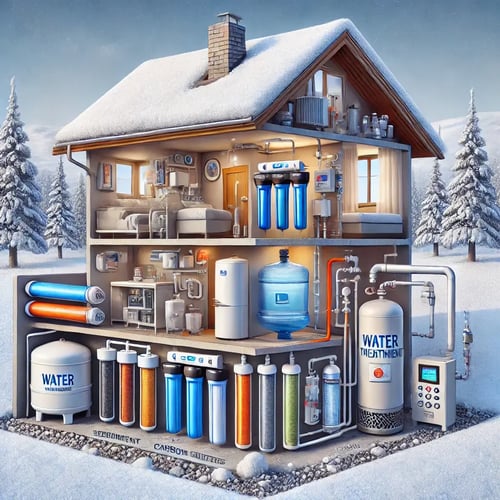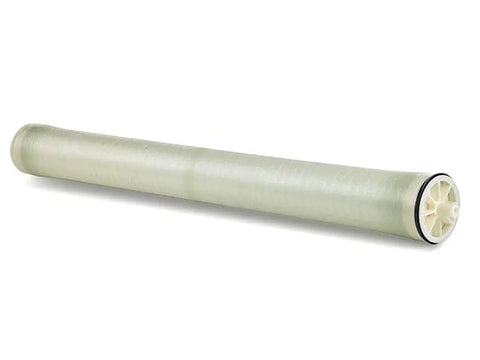Household Water Treatment System for Cold Climate Countries
Clean water is an essential basic need for human life. However, in cold climates, providing clean, quality water can be a challenge. A household water treatment system specifically designed for cold climates is an effective solution to ensure a safe and healthy water supply for families. In this article, we will take an in-depth look at designing household water treatment systems for cold climates, from the source of water to the point of use.
Introduction

Cold climates bring unique challenges in domestic water treatment. Low temperatures can affect the performance of water treatment systems, cause pipe freezing, and affect the effectiveness of certain treatment processes. Therefore, designing the right water treatment system for cold climates is essential to ensure a consistent, high-quality water supply throughout the year.
Household water treatment systems in cold climates generally consist of several major components, including water storage, pumps, filters, water softening, and sometimes reverse osmosis (RO) systems. Each of these components must be selected and designed with cold climate conditions in mind to ensure optimal performance.
The source of water for households usually comes from municipal water or wells, or sometimes a combination of both. Well water often faces issues with iron, manganese, and possible bacterial contamination due to leaks from septic tanks. On the other hand, municipal water that uses river water can also be contaminated with household and cottage industry waste, requiring additional treatment.
In designing a water treatment system for households, it is important to understand how the water is treated.
In designing a water treatment system for cold climates, we need to consider various factors such as water source quality, domestic water demand, ambient temperature, and user preferences. An effective system should be able to address common issues such as high iron content, water hardness, bacterial contamination, and potential freezing of water.
Main Components of Household Water Treatment System for Cold Climate
1. Water Storage and Distribution

An efficient water storage system is essential in cold climates. Storage tanks should be well insulated to prevent freezing and placed in an area protected from extreme temperatures. The Wellmate pressure tank is a good choice for maintaining water pressure throughout the home. These tanks ensure the pump does not need to turn on every time the tap is opened, saving energy and extending the life of the pump.
A water distribution system typically consists of a raw water tank from a well or city water, a pump, a filter, a roof-top storage tank, a distribution pump, which then branches off to the Wellmate tank, check valves, and finally to showers, faucets, and other appliances. It is important to ensure all pipes are well insulated to prevent freezing.
2. Filtration and Water Softening

Filtration is an important step in water treatment, especially for well water that may contain sediment, iron, and manganese. Clack's Birm media or trilite are effective for removing iron from water. For water with low iron content, direct water softening can also be an option.
Water softening systems use ion exchange resins to remove hardness-causing minerals such as calcium and magnesium. The Purolite ion exchange resin is a good choice for water softening systems.
3. Disinfection

Water disinfection is essential to remove bacteria and other pathogens. Chlorination is a commonly used and effective method. Although some people dislike the smell of chlorine, it is important to remember that this is a sign of water that has been properly disinfected. Another alternative is to use an ultraviolet (UV) system for disinfection. Hydropro's UV system can be a good option for chemical-free disinfection.
4. Reverse Osmosis (RO)

For households that want very high quality drinking water, a reverse osmosis (RO) system can be an option. RO systems are effective in removing various contaminants, including microplastics. Pentair Merlin's under-sink RO system is a good choice for point-of-use (POU) use.
5. Pressure Tank and Pump

A pressure tank like the Wellmate is important for maintaining consistent water pressure throughout the home. An efficient, cold-resistant pump is also important. is a good choice for RO systems.
Designing Water Treatment Systems for Different Scenarios
Scenario 1: Well Water with High Iron Content
For homes with well water sources that have high iron content, the water treatment system may consist of:
- Aeration to oxidize iron
- Filtration using Birm Clack media or greensand manganese
- Water softening using Purolite resin
- Disinfection using chlorine or UV systems
- Storage in Wellmate pressure tank
Scenario 2: Municipal Water with High TDS
For homes using municipal water with high Total Dissolved Solids (TDS), systems may include:
- Initial filtration using Pentair Pentek filter cartridges
- Whole house RO system using DuPont FilmTec membranes
- Remineralization to balance pH
- Final UV disinfection
- Storage and distribution using pressure tanks
Scenario 3: Municipal Water with Good Quality
For homes with good quality municipal water, a simpler system may suffice:
- Carbon filtration to remove chlorine and improve taste
- Water softening if required
- A point-of-use RO system Pentair Merlin for drinking water
Special Considerations for Cold Climates
In designing a water treatment system for cold climates, some special considerations need to be taken into account:
- Isolation: All components of the system, including pipes, tanks, and treatment equipment, must be well insulated to prevent freezing.
- Insulation.
- Placement: As much as possible, place system components indoors where they are protected from temperature extremes.
- Placement.
- Heating: Consider using trace heaters on pipes that are susceptible to freezing.
- Heaters.
- Freeze-resistant materials: Use materials and equipment specifically designed to withstand low temperatures.
- Temperature monitoring: Install a temperature monitoring system to warn if temperatures are approaching freezing.
- Temperature monitoring.
Maintenance of Water Treatment Systems in Cold Climates
Routine maintenance is essential to ensure the water treatment system functions optimally in cold climates:
- Check the insulation periodically and repair any damage.
- Clean or replace filters as per recommended schedule.
- Check and recalibrate chemical dosing system regularly.
- Perform backwash on filtration system as needed.
- Check RO system performance and replace membranes if required.
- Make sure the trace heating system is functioning properly before winter.
Conclusion
Designing a domestic water treatment system for cold climates requires special consideration and careful planning. By choosing the right components, such as Pentair FRP filter tanks, Birm Clack media, and Wellmate pressure tanks, as well as paying attention to proper insulation and placement, we can create an effective and long-lasting system.
It is important to remember that there is no "one-size-fits-all" solution in household water treatment. Each home may have different needs and challenges depending on the water source, water quality, and occupant preferences. Therefore, consultation with a water treatment expert and a thorough water quality analysis are highly recommended before designing and implementing the system.
With a well-designed water treatment system, families in cold climates can enjoy clean, safe, and high-quality water all year round, without worrying about the impact low temperatures have on their water supply. Investing in a proper water treatment system not only improves the quality of life but also protects the long-term health of all family members.
Questions and Answers
1. Why is chlorination important in household water treatment, and how to deal with chlorine odor?
Chlorination is essential in household water treatment because it effectively kills bacteria, viruses, and other pathogenic microorganisms. Although some people dislike the smell of chlorine, it is actually an indicator that the water has been properly disinfected. To combat chlorine odor, you can use an activated carbon filter at the point of use or use a simple aeration system to remove odor before consumption.
2. Is a reverse osmosis (RO) system always necessary in domestic water treatment in cold climates?
Not always. The need for an RO system depends on the quality of the water source and the user's preference. If the source water is of good quality and meets drinking water standards, an RO system may not be necessary. However, if the water has a high TDS content or there are concerns about certain contaminants such as microplastics, an RO system could be a good option. For homes with good water quality, a point-of-use RO system like Pentair Merlin may be sufficient for drinking water needs.
3. How best to protect water treatment systems from freezing in extremely cold climates?
To protect water treatment systems from freezing in very cold climates, some steps that can be taken include: - Placing as many system components as possible in an insulated and heated room. - Using high-quality insulation on all pipes and tanks. - Installing a trace heating system on pipes that are prone to freezing. - Ensuring constant water circulation in the system. - Using materials and equipment specifically designed to withstand low temperatures. - Installing temperature monitoring systems with alarms to detect potential freezing. A combination of these measures will help ensure the system remains functional even in extremely low temperature conditions.
References
1. Byrne, W. "Reverse osmosis: A practical guide for industrial users." (p. 171) "Most water treatment systems are not designed to handle more than a 6- to 10-fold loss of pressure across the cartridge filters. This limitation on how small the membrane pores can be is due to the risk of the flat sheet membrane getting clogged or damaged."
2. Binnie, C., & Kimber, M. "Basic Water Treatment (5th Edition)." (p. 246) "It would be normal for part of the reserve storage to be in a clear water tank at the outlet from the treatment works. This has the advantage of having part of the storage available to all the water supply zones served by a works, and it also dampens any variations of the quality of the water produced by the treatment works."
3. Spellman, F. R. "Handbook of water and wastewater treatment plant operations." (p. 652) "The effectiveness of disinfection is measured by testing for the presence or absence of coliform bacteria, which are generally not pathogenic but indicate the possibility of contamination."
4.
4. Hendricks, D. W. "Fundamentals of water treatment unit processes: physical, chemical, and biological." (p. 79) "Source waters, typical contaminants treated, and the purpose of the product water. The variety of treatment situations is discussed, including treatment of high-quality surface waters for drinking water, treated municipal wastewater being further treated for agricultural use, industrial cooling water, injection to groundwater, and a contaminated groundwater being renovated by treatment and re-injected into an aquifer."
5. Binnie, C., & Kimber, M. "Basic Water Treatment (5th Edition)." (p. 16) "Absolutely pure water is never found in nature and it is increasingly rare to encounter a source of water that requires no treatment before being used for potable-water supply. Water contains both biological and inorganic matter."

.png?width=50&height=50&name=Logo_Watermart_Perkasa-removebg-preview%20(1).png)


